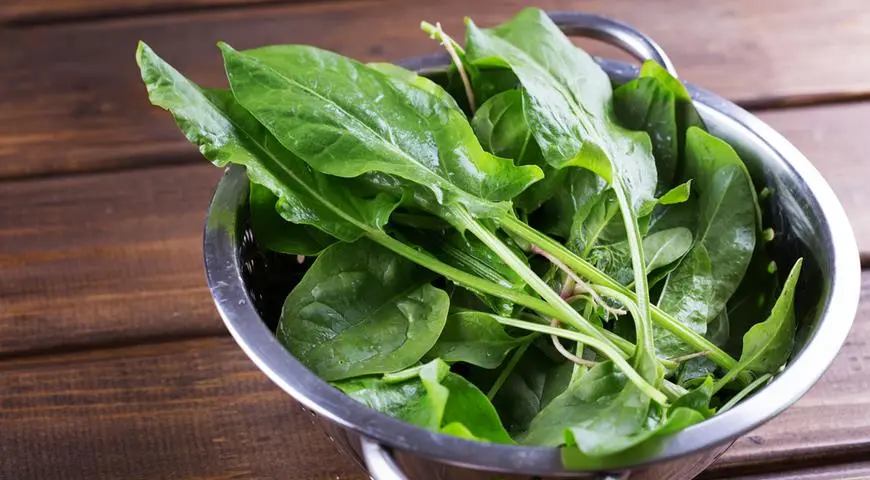Contents
Description
Sorrel is also called the “spring king”, the greenы of this plant is one of the first to appear on the garden beds in early spring and pleases us with its freshness and sour taste. Few people know that sorrel is the closest relative of buckwheat, and just like buckwheat, it is very useful for the body.
Many health problems can be solved by consuming this vegetable. The rich vitamin and mineral composition easily explains all the unique healing and beneficial properties of sorrel.

Sorrel, like rhubarb, is classified as a perennial herb of the buckwheat family. Sorrel grows on all continents – in ravines, in meadows, forest edges, along the banks of rivers and swamps. There are about 200 species of sorrel, 25 species are found in Ukraine. Many species of sorrel are considered weeds, but some can be eaten, including sour sorrel. This plant variety is cultivated in Ukraine and is actively used in cooking.
Composition and calorie content

The young leaves of this plant are used to treat a wide variety of diseases due to its unique composition. Sorrel contains vitamins C, K, E, B vitamins, biotin, β-carotene, essential oils, tannic, oxalic, pyrogallic and other acids.
Also, sorrel contains mineral elements: magnesium, calcium, phosphorus, iron, etc. The nutritional composition of sorrel is quite rich, 100 g of fresh herbs contain:
- 2.3 g protein
- 91.3 g water
- 0.4 g fat
- 0.8 g fiber
- 1.4 g of ash.
The energy value of sorrel is 21 kcal per 100 g, which is not at all a lot, considering also the benefits that these greens will bring to the body, sorrel can be used by everyone, regardless of whether you are following your figure or not.
The benefits of sorrel

All parts of the plant are used for medicinal purposes. The use of sorrel relieves scurvy, vitamin deficiency, anemia. Due to the high content of vitamin C, iron absorption increases, and as a result, hemoglobin in the blood rises. Sorrel in large doses can be used as a laxative, and in small doses as a fixative.
With gastritis with a weak secretion of gastric juice, consumption increases acidity and normalizes digestion. Small doses of oxalic juice have a choleretic effect on the body. Traditional medicine advises using infusions from the leaves and roots of the plant as a hemostatic and anti-inflammatory agent.
The green parts and the sorrel fruit have astringent, analgesic, anti-inflammatory and antitoxic properties. A decoction of young leaves improves bile secretion, the functioning of the liver and intestines, acts as an antidote for certain poisonings.
A decoction of sorrel roots cures bloody diarrhea, back pain and rheumatism. Sorrel is used to treat colitis, enterocolitis, gastrointestinal tract diseases and hemorrhoids.
A large supply of vitamins (in particular ascorbic acid) allows you to solve problems with spring vitamin deficiencies. Young green leaves of the plant cover most of the vitamin deficiency.
Sorrel has been successfully used to treat the heart and blood vessels. Oxalic acid removes harmful cholesterol from the body, keeps muscles and nerves in good shape.
Sorrel is used to get rid of the problems that arise during menopause: it prevents uterine bleeding, reduces sweating, relieves headaches, and normalizes blood pressure. The B vitamins, which are part of sorrel, normalize the nervous system and participate in cell renewal.
Plant fibers stimulate the intestines, remove toxins and toxins from the body.
Sorrel harm

Despite all the useful properties of the plant, it is not advisable to abuse it. Excessive consumption of sorrel can cause urolithiasis. Sorrel is not recommended to be included in the diet for inflammation in the kidneys and intestines, gastritis with high acidity, for peptic ulcer disease and for disorders of water-salt metabolism.
Sorrel does not allow calcium to be fully absorbed, which can lead to the development of osteoporosis. An excess of oxalic acid leads to gout and uremia. The first sign of these serious diseases is sugar and calcium oxalate salts in the urine.
Sorrel salad with egg and cucumber

- Sorrel – 100 g
- Cucumbers – 2 pcs.
- Chicken eggs – 2 pcs.
- Green onions – 2 branches
- Dill – 3 branches
- Sour cream – 2 tbsp.
- Salt to taste
- Ground black pepper – to taste
Preparation
- The first step is to put the eggs to boil. Cook them hard-boiled – 9-10 minutes after boiling. Cool and clean. Then wash the herbs and cucumbers, let them dry. Cut off the coarse petioles of the sorrel, and tear the leaves into small pieces.
- Put the sorrel on a plate
- Finely chop the green onion and dill.
- Cut the cucumbers into strips.
- Cut the eggs into quarters lengthwise. Combine all ingredients.
- Mix sour cream, salt and black pepper separately. Pour the resulting dressing over the salad.
Sorrel salad with egg and cucumber - Delicious, fresh sorrel salad with egg and cucumber is ready. Serve immediately after cooking.
Bon Appetit!









